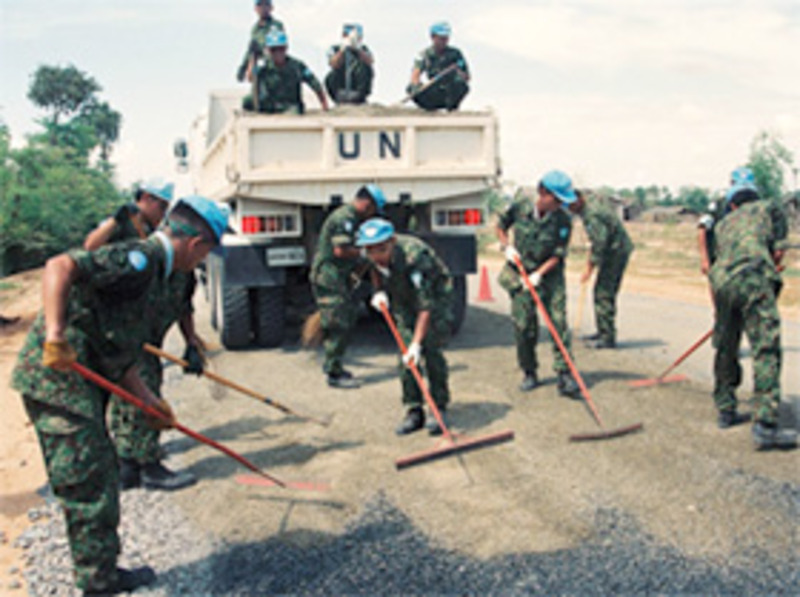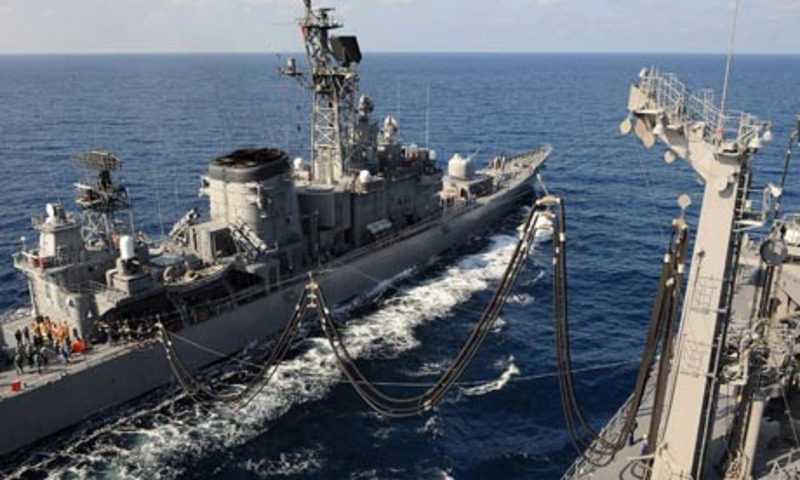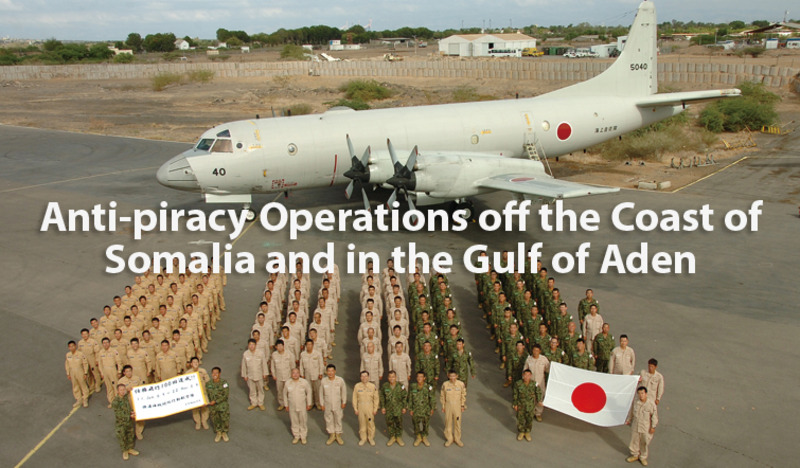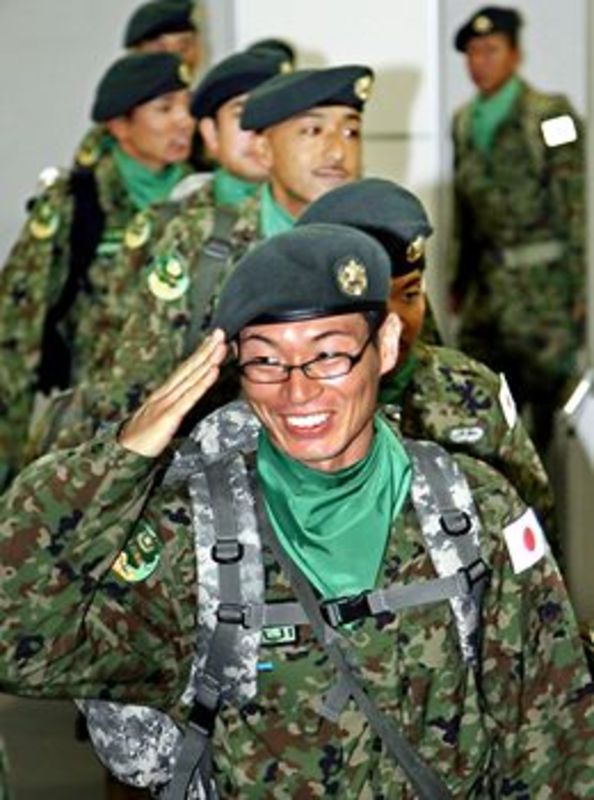Translated by Richard H. Minear
Regardless of Prime Minister Abe’s attempt to make the case that collective self-defense is constitutional, for some time the Self-Defense Forces have been working to achieve for Japan the status of a “state that can wage war overseas.” Behind this movement wriggles U.S. intent.
“Solely defensive” has been rescinded and the ground prepared for the coming right of collective self-defense. Consider the following examples.
April 26, 1991: Dispatch of Minesweepers to the Persian Gulf.
The SDF’s first dispatch overseas: the sending of six minesweepers and auxiliary vessels to the Persian Gulf. After the Gulf War, they set about clearing the mines launched during the war. In the Diet, there was criticism that “the dispatch of SDF overseas is unconstitutional,” but the Kaifu Cabinet forced through the rubrics of “police action” and “international contribution.” This became one important step in the ever-growing overseas dispatch of the SDF thereafter.
August 19, 1992: Dispatch of the Cambodia Peace Keeping Mission.
In accordance with the June 1992 Law of Cooperation in International Peace-Keeping, a Ground SDF construction battalion was dispatched under the auspices of the United Nations Transitional Authority in Cambodia (UNTAC).
Through September 1993 a total of 1200 soldiers undertook duties such as repairing roads and bridges. At the start there was opposition, but from then till now thirteen dispatches abroad of the SDF have been carried out (the only current one is to the southern Sudan). But in Cambodia the repair of roads was entrusted to specialists outside the SDF, so it can be said that the rubric of “international cooperation” was intended to justify the overseas dispatch as an established fact.
May 28, 1999: Approval of the Regional Affairs Law. The enactment of a law that if the U.S. begins a war under “regional affairs”—even if Japan is not attacked, Japan too can take part automatically as “rear support.” This “regional affairs” means that “If matters take their course…Japan has the capability to have an important influence on our peace and security in Japan’s region;” it was formulated not as a geographical concept. It is clear that if Japan gives “aid” to the U.S. military during war even as “rear support,” this becomes the “exercise of military force;” and it easily links up with the right of collective self-defense.
 |
 |
|
SDF engineering unit repairing roads in Cambodia, 1992-93 |
Japan Maritime Self Defence Force (JMSDF) ship ‘Mashu’ conducts a refueling exercise in Japan Sea after returning from Indian Ocean, 2009. |
November 9, 2001: Dispatch of Maritime Self Defense Ships under the Anti-Terror Law.
In October 2001, one month after September 11, the U. S. military and NATO forces began the invasion of Afghanistan. In support, the Koizumi Cabinet enacted the Special Terror Law on October 29 and the following month dispatched three SDF ships to the Indian Ocean. Up to January 2010, 73 ships of the Maritime SDF (including those in the Arabian Sea) resupplied some 3,000,000 barrels of oil to ships from twelve countries, including the U.S. and Great Britain (75% of the ships resupplied were American). This meant that ships of the Navy SDF took part both in Afghanistan via carrier-based fighter planes and ship-fired cruise missiles and, contrary to the intent of the law, in the air campaign in Iraq that began in 2003. That is, the SDF lent its support to mayhem against innocent civilians.
January 9, 2004: Participation in the Iraq War under the Iraq War Law.
The dispatch to Iraq of about 9,600 Ground SDF personnel is reported as “support for humanitarian restoration,” but the formal name of the very specific act passed in July 2003 is “Special Legislation concerning Support of Humanitarian Restoration Activities in Iraq and Implementation of Activities in Support of Peace and Security;” these “activities in support of peace and security” were military support for the U.S. military’s aggression.
|
SDF forces depart for Iraq (2003) |
In fact, in its decision of April 2008 on the group “appeal to stop the dispatch of the SDF to Iraq”, the Nagoya Supreme Court acknowledged that Air SDF transport activities between Kuwait and Baghdad, which was a battle zone, were the “regular and reliable delivery of armed personnel of the multi-national forces.” It found them unconstitutional: “It was activity integral to other countries’ use of military force and can only be considered Japan’s own exercise of military force.”
October 29, 2005: Publication of “The Japan-U.S. Alliance: Transformation and Realignment for the Future.”
Article 6 of the U.S.-Japan Mutual Security Treaty states clearly that bases in Japan can be used “For the purpose of contributing to the security of Japan and the maintenance of international peace and security in the Far East.” According to the opinion of the government, “Far East” meant “Japan and surrounding territories from the Philippines north.” But in the document “The U.S. Japan Alliance: Transformation and Realignment for the Future,” signed by Japan’s foreign minister and chief of the Defense Agency and the U. S. secretaries of State and Defense, the Koizumi Cabinet emphasized that “the close and cooperative relations based on this alliance play an important role in dealing effectively with world issues.” With the “Far East” rubric purged, the Mutual Security Treaty in fact had been made a dead letter. Moreover, as “the roles, missions, and capabilities” of the SDF and the U.S. military, this phrase made its appearance: “efforts to improve the international security environment.” This has been reinterpreted as a different expression—to carry out intervention and interference, including military coups, in foreign countries, against a backdrop of U.S. military force. That is, this is a declaration that, with no relation to whether there is an “attack” on Japan proper, Japan will cooperate with U. S. military invasion worldwide.
January 9, 2007: Revision of the Self Defense Forces Act.
Article 3 of the old SDF law states: “In order to defend the peace and independence of Japan and protect the country’s security, its chief duty is to defend the country against direct or indirect invasion.” But Section 2 of Article 3 of the revised law adds: “1…activities to contribute to insuring Japan’s peace and security, taken in response to situations that have an important influence on Japan’s peace and security in areas in Japan’s neighborhood. 2. Activities to contribute to efforts at international peace under the UN and by encouraging other international cooperation to embrace support of the peace and security of international society including Japan….” Until that point, SDF activities abroad had been treated under “miscellaneous regulations;” now for the first time they were elevated to “basic duties.” The result was the equivalent of actually abandoning “solely defensive,” and the nature of the SDF fundamentally changed.
March 14, 2009: The Dispatch of Maritime Self Defense Forces to Somalia and the Construction of the First Foreign Base.
Under the rubric of “naval patrol against pirates [in the waters off Somalia],” two Navy SDF ships were dispatched in March 2009. In June the “law for dealing with sea piracy” was enacted, becoming the first post-war SDF law for the regular dispatch of the SDF abroad that did not restrict the sphere or duration of operations.
 |
As a result, at any time, in the name of police action against pirates, SDF ships can be dispatched worldwide, and attack actions including the bombardment of ships can take place. Moreover, beginning in April 2009 two P3C patrol planes were added, and in July 2010, as the establishment of a squadron for the two planes, the first postwar overseas base of the SDF (i.e., a base for overseas dispatch) was established in Somalia’s neighbor Djibouti. To guard the facility the Ground SDF was dispatched, too.
????: The Participation of Self Defense Forces in Attacks.
In his May 15 press conference, Prime Minister Abe declared, “The SDF will not join in attacks,” but following a governing party consultation, a policy was announced to do away with the restriction that targets of SDF dispatch be “non-battle zones;” up till then, that restriction had avoided “integration” into military operations. It is clear that should this happen, SDF activities in war zones will be broadened at one fell swoop and will develop into exchanges of fire with “enemies;” the Prime Minister is trying to make it a pretext for introducing SDF battle units.
Commentary: For some time, Japan had proceeded in the direction of making it possible to invoke the right of collective self-defense. First, the U.S.-Japan Mutual Security Treaty—whose context was individual self-defense—in effect was shelved. Then the “U.S.-Japan Alliance in the World,” which surfaced at the May 2003 meeting of then-P.M. Koizumi and then-President Bush, was urged forward on all fronts with absolutely no basis in treaty. Thereupon preparations began that could involve the SDF in U.S. military actions in Asia, the Pacific, and even the Middle East. Before and after 2000 the following occurred:
- organizational integration with the U.S. military;
- greater frequency of joint maneuvers with the U.S. military and the strengthening of their practical nature; and
- granting the SDF armaments and functions in the nature of military expeditionary forces.
At one swoop all these tendencies deepened. Participation in the two wars—Afghanistan and Iraq—changed the SDF into a foreign expeditionary force, and now an overseas base in Djibouti has been established. The “U.S. and Japan: Toward a Mature Partnership” (2000, the first Armitage-Nye Report), a bipartisan U.S. document dealing with Japan, contains the demand that “Japan should recognize the exercise of collective self-defense.” There is no doubt that for the future the U. S. is pushing Japan to prepare for a more expansive role.
Narusawa Muneo is an editorial writer for Shūkan Kinyōbi, where this article appeared on June 13, 2014.
Richard H. Minear is the author of Victors’ Justice: The Tokyo War Crimes Trial (1971) and Dr. Seuss Goes to War (1999) and the editor of Through Japanese Eyes (4th edition 2007). He is translator of Requiem for Battleship Yamato (1985), Hiroshima: Three Witnesses (1990), Black Eggs (1994), the autobiographies of Ienaga Saburo (2001), Nakazawa Keiji (2010), and Ōishi Matashichi (2011), writings of Takeyama Michio (2007), and Nambara Shigeru (2010). He is a Japan Focus associate.
Recommended citation: Narusawa Muneo, “The Overseas Dispatch of Japan’s Self-Defense Forces and U.S. War Preparations”, The Asia-Pacific Journal, Vol. 12, Issue 31, No. 2, August 4, 2014.




